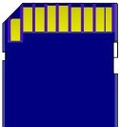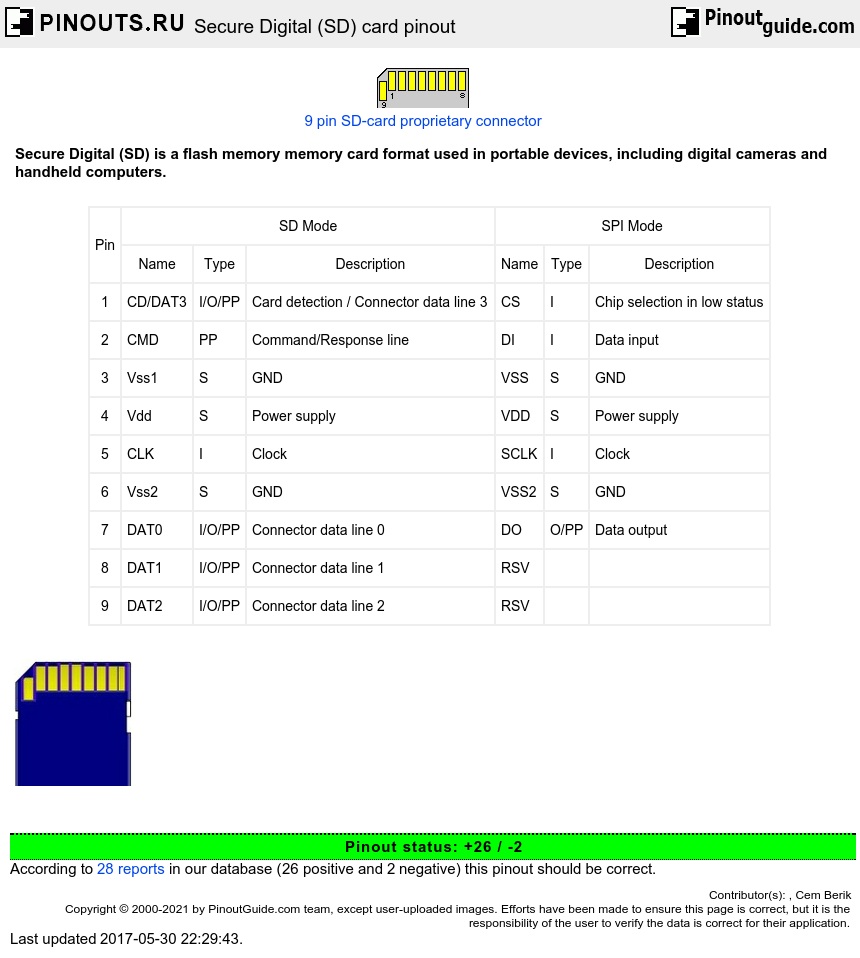SD cards are based on the older Multi Media Card (MMC) format, but most are physically slightly thicker than MMC cards. They also boast higher data transfer rates. DRM features are available but are little-used. SD cards generally measure 32 mm × 24 mm × 2.1 mm, but can be as thin as 1.4 mm, just like MMC cards.
There are different speed grades available. They are referred to with the same nx notation as CD-ROMs; a multiple of 150 kB/s. Devices with SD slots can use the thinner MMC cards, but the standard SD cards will not fit into the thinner MMC slots. MiniSD and MicroSD cards can be used directly in SD slots with an adapter. There are readers which allow SD cards to be accessed via many connectivity ports such as USB, FireWire.
| Pin | SD Mode | SPI Mode | ||||
| Name | Type | Description | Name | Type | Description | |
| 1 | CD/DAT3 | I/O/PP | Card detection / Connector data line 3 | CS | I | Chip selection in low status |
| 2 | CMD | PP | Command/Response line | DI | I | Data input |
| 3 | Vss1 | S | GND | VSS | S | GND |
| 4 | Vdd | S | Power supply | VDD | S | Power supply |
| 5 | CLK | I | Clock | SCLK | I | Clock |
| 6 | Vss2 | S | GND | VSS2 | S | GND |
| 7 | DAT0 | I/O/PP | Connector data line 0 | DO | O/PP | Data output |
| 8 | DAT1 | I/O/PP | Connector data line 1 | RSV | ||
| 9 | DAT2 | I/O/PP | Connector data line 2 | RSV | ||
SD cards interface is compatible with standard MMC card operations. All SD memory and SDIO cards are required to support the older SPI/MMC mode which supports the slightly slower four-wire serial interface (clock, serial in, serial out, chip select) that is compatible with SPI ports on many microcontrollers. Many digital cameras, digital audio players, and other portable devices probably use MMC mode exclusively. MMC mode does not provide access to the proprietary encryption features of SD cards, and the free SD documentation does not describe these features. As the SD encryption exists primarily for media producers, it is not of much use to consumers who typically use SD cards to hold unprotected data.
There are three transfer modes supported by SD: SPI mode (separate serial in and serial out), one-bit SD mode (separate command and data channels and a proprietary transfer format), and four-bit SD mode (uses extra pins plus some reassigned pins) to support four bit wide parallel transfers. Low speed cards support 0 to 400 kbit/s data rate and SPI and one-bit SD transfer modes. High speed cards support 0 to 100 Mbit/s data rate in four-bit mode and 0?25 Mbit/s in SPI and one-bit SD modes.
SD cards security features includes:
- Copyright protection mechanism with the SDMI standard (Secure Digital Music Initiative)
- Integrated CPRM file protection and encryption system (CPRM is a Content Protection for Recordable Media)



 correct
correct incorrect
incorrect